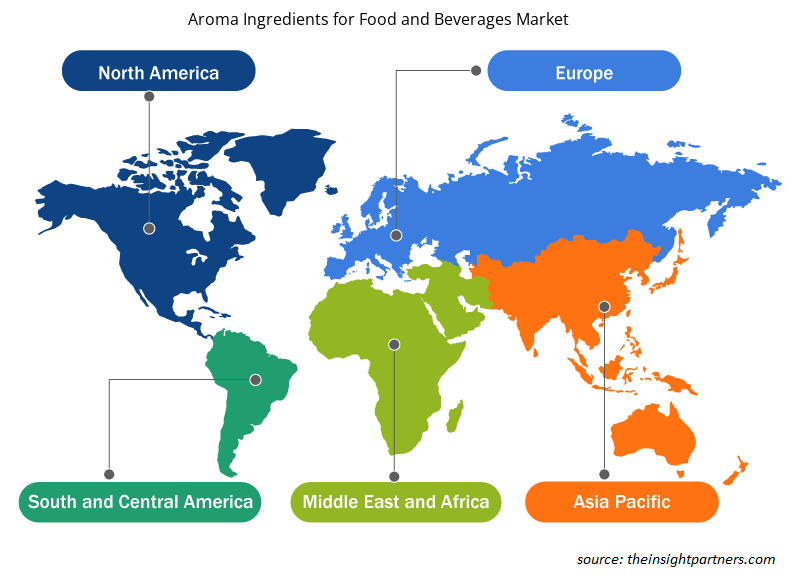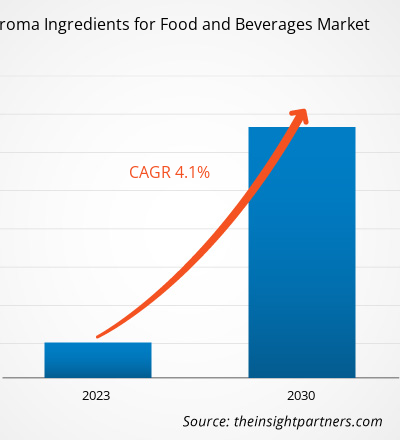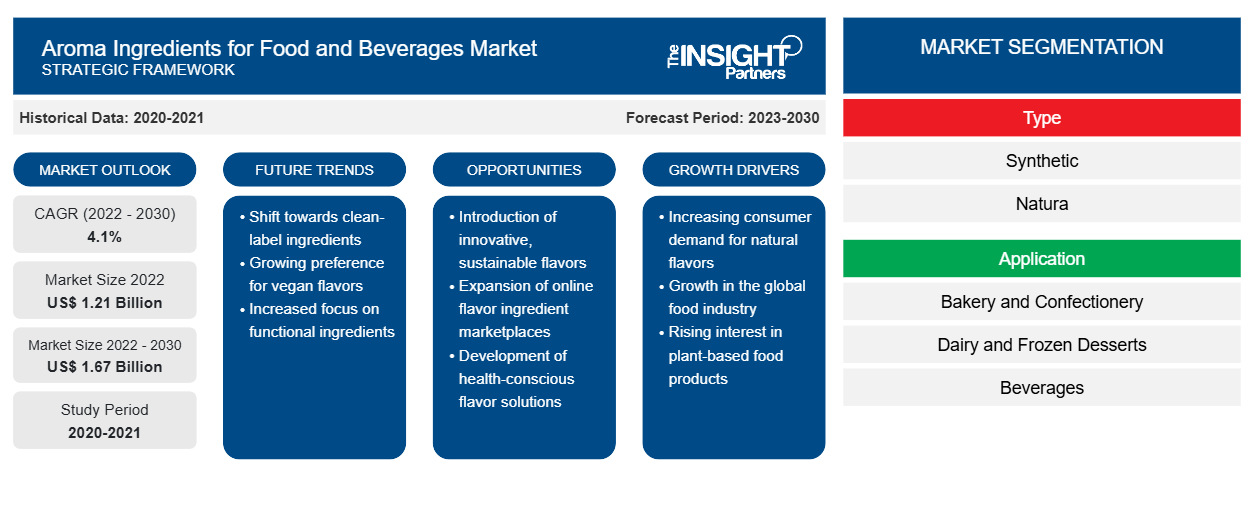[تقرير بحثي] من المتوقع أن ينمو حجم سوق مكونات النكهة للأغذية والمشروبات من 1.21 مليار دولار أمريكي في عام 2022 إلى 1.67 مليار دولار أمريكي بحلول عام 2030؛ ومن المتوقع أن يسجل السوق معدل نمو سنوي مركب بنسبة 4.1٪ من عام 2022 إلى عام 2030.
رؤى السوق ووجهة نظر المحلل:
يتم عزل مكونات النكهة من مكونات ذات مصدر طبيعي أو يتم استخراجها كيميائيًا من البترول. تلعب هذه المكونات دورًا حاسمًا في تشكيل ملف النكهة والرائحة لمختلف الأطعمة والمشروبات، بدءًا من الحلويات والوجبات الخفيفة اللذيذة إلى المشروبات الكحولية وغير الكحولية. تعد الأهمية المتزايدة لمكونات النكهة في صناعة الأغذية والمشروبات والمبادرات الاستراتيجية من قبل اللاعبين الرئيسيين في السوق من العوامل الرئيسية التي تدفع مكونات النكهة لسوق الأغذية والمشروبات. بالإضافة إلى ذلك، فإن الطلب المتزايد من المستهلكين على تجارب النكهة والرائحة الفريدة والغريبة، بالإضافة إلى التقدم في تقنيات الاستخراج والتوليف، يساعد بشكل أكبر في تشكيل مشهد السوق. ومع ذلك، فإن القيود التنظيمية المرتبطة باستخدام مكونات النكهة في صناعة الأغذية والمشروبات تعيق نمو سوق مكونات النكهة للأغذية والمشروبات .
محركات النمو والتحديات:
يشارك مصنعو مكونات الروائح في صناعة الأغذية والمشروبات بشكل كبير في عمليات الدمج والاستحواذ والتعاون والتطورات الاستراتيجية الأخرى لجذب المستهلكين وتعزيز مكانتهم في السوق. أدى الطلب المتزايد على مكونات الروائح من مختلف مؤسسات الأغذية والمشروبات التي تنتج وتبيع المخبوزات والحلويات ومنتجات الألبان والحلويات المجمدة وغيرها من العناصر إلى قيام اللاعبين الرئيسيين بتبني مبادرات استراتيجية لتعزيز مكانتهم في السوق عالميًا. على سبيل المثال، في نوفمبر 2023، أعلنت شركة BASF SE عن إطلاق مكونين جديدين للروائح الطبيعية: Isobionics Natural alpha-Bisabolene 98 و Isobionics Natural (-)-alpha-Bisabolol 99. مثل هذه التطورات في المنتجات تدفع مكونات الروائح لسوق الأغذية والمشروبات.
يقوم اللاعبون الرئيسيون في السوق بتوسيع مرافق الإنتاج الخاصة بهم وإبرام اتفاقيات مع الموزعين لتعزيز مكانتهم في السوق. على سبيل المثال، في ديسمبر 2021، أعلنت شركة Tilley Distribution، Inc. عن الاندماج مع Phoenix Aromas and Essential Oils. سيساعد الاندماج في توفير منتجات عالية الجودة لقواعد المستهلكين الجديدة والحالية مع فرق ذات خبرة في تقديم الدعم التنظيمي والفني. بالإضافة إلى ذلك، في يوليو 2021، استحوذت شركة Symrise AG على شركة Giraffe Foods Inc. ومقرها كندا، وهي شركة كندية منتجة للصلصات المخصصة والصلصات والتوابل والشراب ومركزات المشروبات للعملاء من الشركات إلى الشركات. سيعمل الاستحواذ على توسيع قطاع النكهات والتغذية لشركة Symrise في أمريكا الشمالية، مما يعزز مكانتها في السوق وقاعدة عملائها. وبالتالي، فإن المبادرات الاستراتيجية من قبل اللاعبين الرئيسيين في السوق تغذي نمو سوق مكونات الروائح العالمية للأغذية والمشروبات.
يتم تنظيم إنتاج واستخدام مكونات النكهة في تطبيقات الأغذية والمشروبات المختلفة من قبل هيئات حكومية مختلفة. تفرض الهيئات التنظيمية مثل إدارة الغذاء والدواء (FDA) وهيئة سلامة الأغذية الأوروبية (EFSA) إرشادات ومعايير صارمة على استخدام مكونات النكهة لضمان سلامة المستهلك وجودة المنتج. على سبيل المثال، قام برنامج الأمم المتحدة للبيئة بتنظيم استخدام نكهات الطعام. توفر هذه اللائحة جميع الشروط اللازمة للاستخدام الصحيح والمراقب والآمن للنكهات والمكونات العطرية أو الروائح في الأطعمة. بالإضافة إلى ذلك، فرضت إدارة الغذاء والدواء (FDA) لائحة على نكهة الطعام التي يمكن استخدامها في الطعام وعليه. يأتي تلبية هذه المتطلبات التنظيمية مع عمليات اختبار وتوثيق مكثفة، والتي يمكن أن تستغرق وقتًا طويلاً وتكلف الكثير من المال بالنسبة للمصنعين. يمكن أن تكون عملية الموافقة على مكونات النكهة طويلة ومعقدة، مما يعيق الابتكار وتطوير المنتجات داخل الصناعة.
قم بتخصيص هذا التقرير ليناسب متطلباتك
ستحصل على تخصيص لأي تقرير - مجانًا - بما في ذلك أجزاء من هذا التقرير، أو تحليل على مستوى الدولة، وحزمة بيانات Excel، بالإضافة إلى الاستفادة من العروض والخصومات الرائعة للشركات الناشئة والجامعات
-
احصل على أهم اتجاهات السوق الرئيسية لهذا التقرير.ستتضمن هذه العينة المجانية تحليلاً للبيانات، بدءًا من اتجاهات السوق وحتى التقديرات والتوقعات.
تقسيم التقرير ونطاقه:
"تحليل سوق المكونات العطرية العالمية للأغذية والمشروبات حتى عام 2030" هي دراسة متخصصة ومتعمقة مع التركيز الرئيسي على اتجاهات السوق وفرص النمو. يهدف التقرير إلى تقديم نظرة عامة على السوق مع تقسيم السوق التفصيلي حسب النوع والتطبيق. شهد السوق نموًا كبيرًا في الماضي القريب ومن المتوقع أن يستمر هذا الاتجاه خلال فترة التنبؤ. يقدم التقرير إحصائيات رئيسية حول استهلاك المكونات العطرية للأغذية والمشروبات على مستوى العالم. بالإضافة إلى ذلك، يوفر تقرير سوق المكونات العطرية العالمية للأغذية والمشروبات تقييمًا نوعيًا للعوامل المختلفة التي تؤثر على أداء السوق على مستوى العالم. يتضمن التقرير أيضًا تحليلًا شاملاً للاعبين الرائدين في السوق وتطوراتهم الاستراتيجية الرئيسية. يتم أيضًا تضمين العديد من التحليلات حول ديناميكيات السوق للمساعدة في تحديد العوامل الدافعة الرئيسية واتجاهات السوق والفرص المربحة التي من شأنها بدورها أن تساعد في تحديد جيوب الإيرادات الرئيسية.
يتم تقدير مكونات النكهة لتوقعات سوق الأغذية والمشروبات على أساس نتائج بحثية ثانوية وأولية مختلفة، مثل منشورات الشركات الرئيسية وبيانات الجمعيات وقواعد البيانات. علاوة على ذلك، يوفر تحليل النظام البيئي وتحليل القوى الخمس لبورتر رؤية شاملة للسوق، مما يساعد على فهم سلسلة التوريد بأكملها والعوامل المختلفة التي تؤثر على أداء السوق.
التحليل القطاعي:
يتم تقسيم مكونات النكهة لسوق الأغذية والمشروبات على أساس النوع والتطبيق.من حيث النوع، ينقسم السوق إلى اصطناعي وطبيعي. ينقسم الجزء الاصطناعي إلى تربين وألدهيدات وأليفاتية وغيرها. ينقسم الجزء الطبيعي إلى زيوت أساسية ومستخلصات عشبية وراتنجات زيتية وغيرها. في عام 2022، احتفظ الجزء الاصطناعي بأكبر حصة في سوق مكونات الروائح للأغذية والمشروبات. ومن المتوقع أن يسجل الجزء الطبيعي أعلى معدل نمو سنوي مركب من عام 2022 إلى عام 2030. مكونات الروائح الاصطناعية هي مركبات كيميائية تحاكي النكهات الطبيعية الموجودة في الأطعمة والمشروبات. يمكن أن يُعزى الارتفاع في الطلب على هذه المكونات في صناعة الأغذية والمشروبات إلى عدة عوامل. أولاً، توفر مكونات الروائح الاصطناعية الاتساق في ملف النكهة، مما يضمن أن المنتجات لها نفس المذاق في كل مرة، بغض النظر عن الاختلافات في المكونات الطبيعية. هذا الاتساق أمر بالغ الأهمية لهوية العلامة التجارية ورضا المستهلك. ثانيًا، توفر فعالية من حيث التكلفة مقارنة بمكونات الروائح الطبيعية، مما يجعلها أكثر سهولة في الوصول إليها من قبل الشركات المصنعة، وخاصة في الإنتاج على نطاق واسع. بالإضافة إلى ذلك، أدت التطورات في علم النكهة إلى تطوير مكونات صناعية تحاكي النكهات الطبيعية عن كثب، مما يرضي تفضيلات المستهلكين للأذواق المألوفة مع تقديم تركيبات نكهات فريدة. وفي الختام، أدت المخاوف بشأن استقرار وتوافر المكونات الطبيعية والضغوط التنظيمية إلى زيادة اعتماد مكونات النكهة الصناعية في صناعة الأغذية والمشروبات.
التحليل الإقليمي:
يركز نطاق السوق على خمس مناطق رئيسية - أمريكا الشمالية وأوروبا وآسيا والمحيط الهادئ والشرق الأوسط وأفريقيا وأمريكا الجنوبية والوسطى. استحوذت منطقة آسيا والمحيط الهادئ على أكبر حصة في سوق مكونات النكهة للأغذية والمشروبات في عام 2022، بقيمة سوقية تبلغ حوالي 425 مليون دولار أمريكي.واستحوذت أوروبا على الحصة الثانية الأكبر، تليها أمريكا الشمالية.
في أوروبا، يمكن أن يُعزى الطلب المتزايد على مكونات الروائح إلى التقاليد الطهوية الغنية في المنطقة والتفضيل المتزايد للمنتجات الفاخرة والحرفية. هناك تقدير ثقافي قوي للتقاليد الطهوية والمأكولات في جميع أنحاء أوروبا. يقدر المستهلكون في أوروبا المكونات عالية الجودة والنكهات الأصيلة، وبالتالي يدفعون الطلب على مكونات الروائح التي تعزز التجربة الحسية. أدى هذا التركيز على التميز الذواقة إلى نمو سوق مكونات الروائح الفاخرة المستمدة من مصادر طبيعية ومستدامة، والتي تلبي الأذواق المميزة للمستهلكين الأوروبيين. بالإضافة إلى ذلك، يساهم الاهتمام المتزايد بخيارات الطعام الأكثر صحة وطبيعية في أوروبا في نمو السوق. لقد تبنى المستهلكون الأوروبيون الأنظمة الغذائية العضوية والنباتية، وغالبًا ما تتضمن مكونات ذات مذاق ورائحة قوية أو غير مألوفة، مثل بعض الخضروات والحبوب والبقوليات؛ لجعل هذه الخيارات الصحية أكثر جاذبية، يستخدم مصنعو الأغذية مكونات الروائح للتخفيف من أي نكهات وعطور طاغية أو غير مقبولة، مما يضمن أن المنتجات تحافظ على قبول واسع النطاق من قبل المستهلكين مع الالتزام باتجاهات العلامات التجارية الطبيعية والنظيفة. ويتماشى هذا الطلب مع جودة الطعام الأوروبي الأوسع نطاقًا، وطعمه، والوعي بالتجربة الحسية، وكل ذلك يساهم في اعتماد مكونات النكهة للأطعمة والمشروبات في المنطقة.
في أمريكا الشمالية، تُعزى مكونات النكهة لسوق الأغذية والمشروبات إلى ارتفاع مبيعات منتجات الأغذية الجاهزة والمعبأة، وصناعة الأغذية الراسخة، والتفضيل المتزايد للمستهلكين للمشروبات الوظيفية. تلعب مكونات النكهة دورًا حيويًا في هذه المنتجات لتعزيز الرائحة العامة للمنتجات، مما يجعلها أكثر جاذبية للمستهلكين. ساهم تفضيل المستهلك المتزايد للمنتجات الطبيعية والنظيفة في نمو السوق. مع استمرار ارتفاع الوعي بالصحة والعافية، يبحث المستهلكون بشكل متزايد عن المنتجات ذات المكونات ذات النكهة الطبيعية. وقد دفع هذا مصنعي الأغذية والمشروبات إلى دمج مكونات النكهة المستمدة من مصادر طبيعية مثل الفواكه والأعشاب والتوابل لتلبية طلب المستهلكين. بالإضافة إلى ذلك، ساهمت اتجاهات سوق مكونات النكهة للأغذية والمشروبات نحو التميز في قطاع الأغذية والمشروبات في زيادة الطلب.
رؤى إقليمية حول مكونات النكهة المستخدمة في سوق الأغذية والمشروبات
لقد قام المحللون في Insight Partners بشرح الاتجاهات والعوامل الإقليمية المؤثرة على سوق مكونات النكهة للأغذية والمشروبات طوال فترة التوقعات بشكل شامل. يناقش هذا القسم أيضًا قطاعات سوق مكونات النكهة للأغذية والمشروبات والجغرافيا في جميع أنحاء أمريكا الشمالية وأوروبا ومنطقة آسيا والمحيط الهادئ والشرق الأوسط وأفريقيا وأمريكا الجنوبية والوسطى.

- احصل على البيانات الإقليمية المحددة لمكونات النكهة لسوق الأغذية والمشروبات
نطاق تقرير سوق مكونات النكهة للأغذية والمشروبات
| سمة التقرير | تفاصيل |
|---|---|
| حجم السوق في عام 2022 | 1.21 مليار دولار أمريكي |
| حجم السوق بحلول عام 2030 | 1.67 مليار دولار أمريكي |
| معدل النمو السنوي المركب العالمي (2022 - 2030) | 4.1% |
| البيانات التاريخية | 2020-2021 |
| فترة التنبؤ | 2023-2030 |
| القطاعات المغطاة |
حسب النوع
|
| المناطق والدول المغطاة |
أمريكا الشمالية
|
| قادة السوق وملفات تعريف الشركات الرئيسية |
|
كثافة اللاعبين في سوق مكونات النكهة للأغذية والمشروبات: فهم تأثيرها على ديناميكيات الأعمال
يشهد سوق مكونات النكهة للأطعمة والمشروبات نموًا سريعًا، مدفوعًا بالطلب المتزايد من المستخدم النهائي بسبب عوامل مثل تفضيلات المستهلك المتطورة والتقدم التكنولوجي والوعي المتزايد بفوائد المنتج. ومع ارتفاع الطلب، تعمل الشركات على توسيع عروضها والابتكار لتلبية احتياجات المستهلكين والاستفادة من الاتجاهات الناشئة، مما يؤدي إلى زيادة نمو السوق.
تشير كثافة اللاعبين في السوق إلى توزيع الشركات أو المؤسسات العاملة في سوق أو صناعة معينة. وهي تشير إلى عدد المنافسين (اللاعبين في السوق) الموجودين في مساحة سوق معينة نسبة إلى حجمها أو قيمتها السوقية الإجمالية.
الشركات الرئيسية العاملة في سوق مكونات النكهة للأغذية والمشروبات هي:
- شركة النكهات والعطور الدولية
- شركة سينسينت تكنولوجيز
- شركة تي هاسيجاوا المحدودة
- باسف اس اي
- في مان فيلس ساس
إخلاء المسؤولية : الشركات المذكورة أعلاه ليست مرتبة بأي ترتيب معين.

- احصل على نظرة عامة على أهم اللاعبين الرئيسيين في سوق مكونات النكهة للأغذية والمشروبات
تطورات الصناعة والفرص المستقبلية:
وفقًا للبيانات الصحفية، فيما يلي قائمة ببعض المبادرات التي اتخذها اللاعبون الرئيسيون العاملون في سوق مكونات النكهة للأغذية والمشروبات:
- في مارس 2023، أعلنت شركة BASF SE عن استثمارها في مصنع جديد في تشانجيانغ بالصين، ومصانع لإنتاج المنثول واللينالول في لودفيجسهافن بألمانيا. سيعمل هذا الاستثمار على توسيع وتنويع سلسلة قيمة مكونات العطور لشركة BASF في ألمانيا وماليزيا ودعم فرص نمو العملاء.
المنافسة والشركات الرئيسية:
تعد International Flavors & Fragrances Inc وSensient Technologies Corp وT Hasegawa Co Ltd وBASF SE وV Mane Fils Sas وSymrise AG وFirmenich International SA وArcher-Daniels-Midland Co وKerry Group Plc وBerje Inc من بين اللاعبين الرئيسيين الذين تم تحديدهم في تقرير سوق مكونات الروائح للأغذية والمشروبات. يركز اللاعبون في السوق العالمية على توفير منتجات عالية الجودة لتلبية طلب العملاء.
- التحليل التاريخي (سنتان)، سنة الأساس، التوقعات (7 سنوات) مع معدل النمو السنوي المركب
- تحليل PEST و SWOT
- حجم السوق والقيمة / الحجم - عالمي، إقليمي، بلد
- الصناعة والمنافسة
- مجموعة بيانات إكسل
التقارير الحديثة
تقارير ذات صلة
شهادات العملاء
سبب الشراء
- اتخاذ قرارات مدروسة
- فهم ديناميكيات السوق
- تحليل المنافسة
- رؤى العملاء
- توقعات السوق
- تخفيف المخاطر
- التخطيط الاستراتيجي
- مبررات الاستثمار
- تحديد الأسواق الناشئة
- تحسين استراتيجيات التسويق
- تعزيز الكفاءة التشغيلية
- مواكبة التوجهات التنظيمية























 احصل على عينة مجانية ل - مكونات النكهة لسوق الأغذية والمشروبات
احصل على عينة مجانية ل - مكونات النكهة لسوق الأغذية والمشروبات